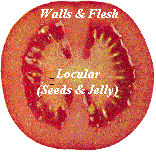|
|
|
|
|
|
Flavor - The consumer evaluates tomatoes on 4 general factors, appearance, firmness, internal  appearance, and flavor will the
professional chef concerns herself or himself more with the two primary
factors determining a tomato's flavor are the sugar and acid content. If
the ratio (percent of sugar divided by the percent of acid) of sugar to
acid is too low the fruit will have a sour or insipid.
Conversely if the sugar ratio is too high the fruit would have an
unnaturally sweet flavor. The
locular
jelly is the most acid portion of the fruit and contains the lowest sugar
content. There for it can be expected that the greater the
percentage of locular jelly in the fruit the lower the sugar/acid ratio
will be. The acid content of the fruit increases until the
mature-green stage is reached and then decreases until the fruits are
fully ripened. There is a rapid rise in the sugar/acid ratio from
the mature-green fruit to the ripened fruit. appearance, and flavor will the
professional chef concerns herself or himself more with the two primary
factors determining a tomato's flavor are the sugar and acid content. If
the ratio (percent of sugar divided by the percent of acid) of sugar to
acid is too low the fruit will have a sour or insipid.
Conversely if the sugar ratio is too high the fruit would have an
unnaturally sweet flavor. The
locular
jelly is the most acid portion of the fruit and contains the lowest sugar
content. There for it can be expected that the greater the
percentage of locular jelly in the fruit the lower the sugar/acid ratio
will be. The acid content of the fruit increases until the
mature-green stage is reached and then decreases until the fruits are
fully ripened. There is a rapid rise in the sugar/acid ratio from
the mature-green fruit to the ripened fruit.
|
